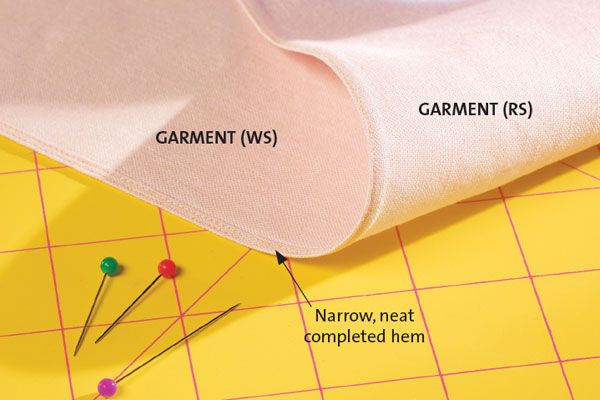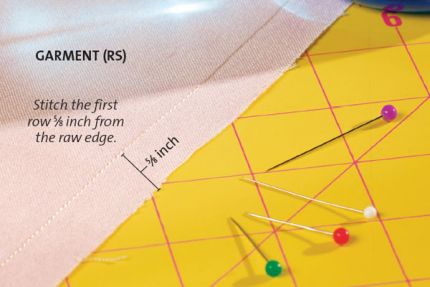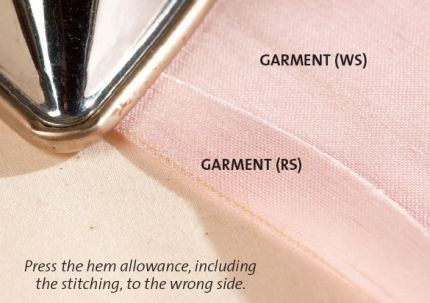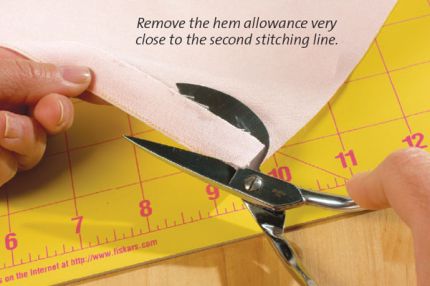
This simple technique allows you to easily add weight to a narrow hem so it hangs straighter than it would if it were sewn with a rolled-hem presser foot. The added weight comes from six threads within 1⁄8 inch of the edge: three from the sewing machine and three from the bobbin.
1. Install a straight-stitch presser foot and throat plate on your sewing machine. This prevents lightweight fabrics from being pulled into the machine. Set your stitch length to 1.5mm. Use a 75/11 quilting needle and 100-percent-cotton thread.
2. Trim away excess fabric.Calculate the finished length of your garment. Add a 3⁄4-inch hem allowance, and trim.
3. Straight-stitch around the hem. With the fabric right-side up, stitch 5⁄8 inch from the raw edge, as shown.

4. Press the hem allowance to the wrong side. Turn the edge so the stitching falls on the hem-allowance side of the fold. Favor the stitching so the fabric fold is barely beyond the line of stitches.

5. Stitch the hem a second time. With the garment wrong side up, stitch 1⁄16 inch from the pressed edge. Stitch through both fabric layers, and use the existing stitching line as your guide. Sew over the first row of stitching (not shown.)
6. Trim the hem allowance. Cut very close to the stitching line you just made (duck-billed appliqué scissors make the job easier).

7. Turn the trimmed and folded edge under. Keep the edge snugly in the fold, and press crisply. No hem stitching should be visible on the right side.>
8. Sew the hem a third time. From the wrong side, sew another stitching line 1⁄16 inch from the hem fold through all stitching layers. As you did in step 5, let the previous row of stitching be your guide.
9. Press the completed hem. Press the narrow hem on both sides to ensure it hangs…
Start your 14-day FREE trial to access this story.
Start your FREE trial today and get instant access to this article plus access to all Threads Insider content.
Start Your Free TrialAlready an Insider? Log in






































I think this is a great way to do a narrow hem. I never would have thought of this myself (I absolutely hate hemming anything) so I am very greatful for this great idea. I plan to use it all the time now. Thank you for the idea!!!!
I like the idea but I can hardly use the instructions because of those 5/8 inches and so on. Threads is an international magazine, could you please include metric measurements for your loyal readers in other parts of the world? Thanks.
I love it! I am putting together a shirred dress for my dd & weight of the fabric is pretty light. Thanks for a great idea!
I've been out of sewing for a while. I'm not a whiz with a sewing machine but I really enjoy sewing. Thank you for such easy & simple instructions!
for MawNicholson,
Hi. I just found a link (re the 70s Simplicity caftan pattern )with a Google search and think you might want to look at it.
http://www.artfire.com/modules.php?name=Shop&op=listing&product_id=1350127
Here is a website to convert measurements from inches to mm.
http://www.engineeringtoolbox.com/inches-mm-conversion-d_751.html
Love the technique and will try it on my next narrow hem.
I also agree with coachgrazina - I grew up sewing with Imperial and US measurements but lately have started using metric measures as I'm just fed up with trying to divide 1 5/8 by 4 and so on. Threads has done a pretty good job of providing metric equivalents in parens next to inches but providing them consistently will help us renegades. :o) (I'm still hopeful the US will convert to metric one day. sigh)
I love this technique and can't wait to try it! Wow! Whether drafting patterns or handing down sewing tips Louise Cutting is the best!
How perfectly clever! Thank You for such a great tip!
I always use this method to hem wedding gowns and bridesmaid dresses.
To make it easier to cut off the excess fabric from the hem, I place tape on the throat plate or arm of my sewing machine (the distance from the needle is the amount I need to cut away before I sew the hem) then I stitch "evenly" all the way around the hem. I never have to measure and mark since my stitching is where I cut off the extra fabric. If I have to hem a gown 3 inches ... then I sew my row of stitches in 2 1/2 inches from the original hem. I cut off the excess old hem 1/8 inch from the stitching, I fold the row of stitching under and stitch right next to the original stitching. To finish the hem completely I turn this row under and stitch it one final time.
I sure agree with Louise; this beats using a rolled hemming foot and the weight of the 6 threads sure helps the hem stay neater.
This looks like an idea for hemming a silk scarf as well. Will have to try it.
This is a good explanation of a narrow hem. I have used them successfully for Prom and Bridesmaid dresses, or anywhere I want an elegant hem that tends to float upward and outward, rather than hanging straight down. I've read of using them on sleeveless armhole, but have not tried that yet.
Narrow hems take a little bit of extra work, but are well worth the effort. And one you have done them a few times, you can easily see when they are appropriate.
Just used this on a three-layer bridesmaid dress (fahion fabric, self-lining, fairly heavyweight chiffon overlay) and it worked perfectly, was headache-free, and was quick! Can't ask for more.
Would this concept work on my bias dress that is silk charmeuse with an accent lining that is an inch longer than the dress.
I need to wear this dress to my son's wedding in 3 weeks!
Contrasting thread - next time please -
Can't wait to try this on the chiffon flower girl dress I am making. Thanks. :)
This is marvelous and I will use them in my next fashion.